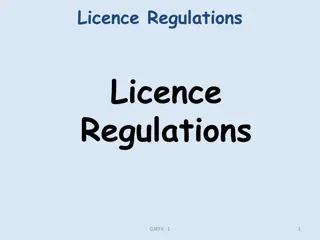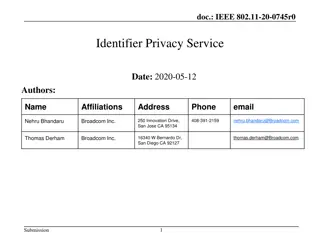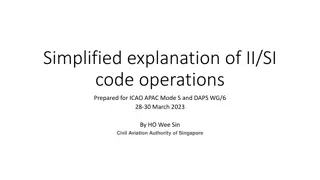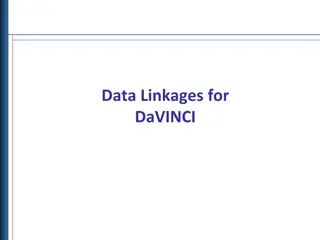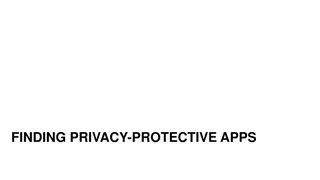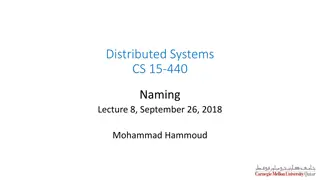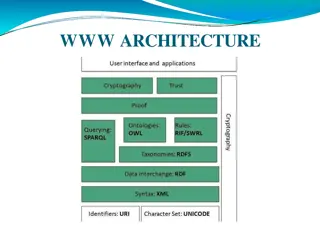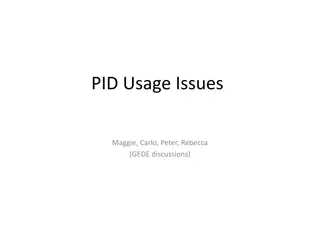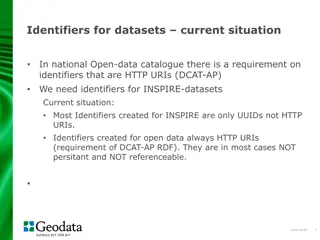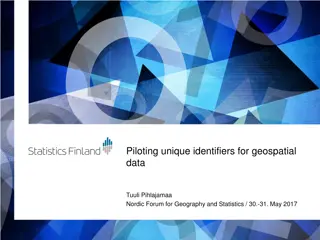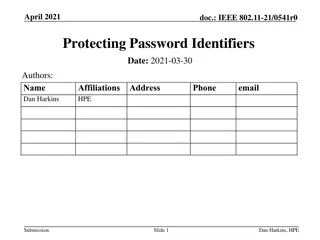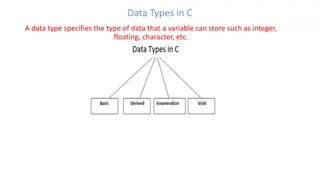
Understanding Identifiers, Memory Space, and Data Types in Programming
Learn about identifiers in programming, the importance of memory space, and different data types used to store data. Explore examples of valid and invalid identifiers, the concept of constants and variables, and the distinction between them in programming. Understand how the state of memory space can be variable or constant, impacting the storage and manipulation of data in computer programs.
Download Presentation

Please find below an Image/Link to download the presentation.
The content on the website is provided AS IS for your information and personal use only. It may not be sold, licensed, or shared on other websites without obtaining consent from the author. If you encounter any issues during the download, it is possible that the publisher has removed the file from their server.
You are allowed to download the files provided on this website for personal or commercial use, subject to the condition that they are used lawfully. All files are the property of their respective owners.
The content on the website is provided AS IS for your information and personal use only. It may not be sold, licensed, or shared on other websites without obtaining consent from the author.
E N D
Presentation Transcript
1. Identifiers 2. Memory Space 3. Data Types 4.Data state 5. Declaration 5.1 Constants 5.2 Variables 6. Examples 2
Identifiers are names of things such as: o Methods: a set of processing operations o Classes Rules for identifiers names include: o May consist only of: Letters (a z or A Z), Digits (0 9), Underscore (_), Dollar sign ($) o Should NOT begin with a digit o Not a reserved word: These are some words used in the Java language. They are interpreted by the compiler to do a specific thing. Examples of reserved words include: public, class, void, etc In our course, reserved words are written in light blue Identifier names are case sensitive: number, Number, NUMBER represent three different identifiers. 3
EXAMPLES OF IDENTIFIERS NAMES EXAMPLES OF IDENTIFIERS NAMES The following identifiers names are valid: o First o payRate o $Amount o employee_salary o _Update The following identifiers names are NOT valid (illegal): o mid-term o add salary o one+two o 2nd o public o - is an illegal character o space is an illegal character o + is an illegal character o must NOT begin with a digit o Reserved word 4
Remember when we said that input need to be saved Remember when we said that input need to be saved output data input data Processing Keyboard Screen Most programs require the temporary storage of data. The data to be processed is stored in a temporary storage in the computer's memory: space memory. A space memory has three characteristics Identifier : Data Type : store in memory State : Identifier : name for that space Data Type : Specifies how much space to State : is it variable ? or Constant is it variable ? or Constant
The state of the space memory is the current value (data) stored in the space memory. The state of the space memory: May be changed. In this case the space memory is called variable. Cannot be changed. In this case the space memory is called constant. 6
Constants: All uppercase, separating words within a multiword identifier with the underscore symbol, _. Variables All lowercase. Capitalizing the first letter of each word in a multiword identifier, except for the first word. 7
The data type defines what kinds of values a space memory is allowed to store. All values stored in the same space memory should be of the same data type. All constants and variables used in a Java program must be defined prior to their use in the program. 8
Constant or Variable First Decision Level Second Decision Level Numeric Character Boolean Third Decision Level Integer Floating-point char String boolean byte float Fourth Decision Level short double int long
PRIMITIVE DATA TYPES (1) PRIMITIVE DATA TYPES (1) - - Integers Integers Java categorizes integer data into the following primitive types: Type byte Size Min. Value Max. Value - 128 = - 27 - 32,768 = - 215 - 2,147,483,648 = - 231 -9,223,372,036,854,775,808 = - 263 + 127 = 27 -1 + 32,767 = 215 - 1 +2,147,483,648 = 231 - 1 + 9,223,372,036,854,775,808 = 263 - 1 8 bits short 16 bits int 32 bits long 64 bits All above types store numbers with no decimal point: integers. Positive integers do not require a + sign in front of them No commas are allowed within integers Note that larger size implies lower minimum and higher maximum Words in blue are reserved words 10
PRIMITIVE DATA TYPES (2) PRIMITIVE DATA TYPES (2) Decimals Decimals Java categorizes decimal (or real) data into the following primitive types: Type Size Min. Value Max. Value Number of Significant bits Up to 7 after the decimal point (Single precision) Up to 15 after the decimal point (Double precision) float 32 bits - 3.4e+38 + 3.4e+38 double 64 bits - 1.7e+308 + 1.7e+308 All above types store numbers with decimal point: floating-point. In Java, real numbers are represented using the floating-point notation: Number 4387 438791 0.0005 0.0000265 Scientific Notation 4.387 * 103 4.38791 * 105 5.0 * 10-4 2.65 * 10-5 Floating-point Notation 4.387e+3 4.38791e+5 5.0e-4 2.65e-5 11
PRIMITIVE DATA TYPES (3) PRIMITIVE DATA TYPES (3) Character Character Type char Size 16 bits Min. Value Max. Value 65,535 = 216 - 1 Description 0 Stores the Unicode of single characters Any key on the keyboard is represented by a char data type Values of char type are enclosed between single quotes such as: A a % $ * & 7 The following values can NOT be represented by a char type: Abc >= Fatma these are rather string types (non-primitive). Note that the space may be represented as a char type Java uses the Unicode coding system to represent characters in memory. Each character has a unique code. There are 65,535 unique codes. For example, the value 65 corresponds to the letter A ; the value 97 represents a ; and so on. The table in the next slide represents all letters codes. In our course, space character is represented by the letter ~ 12
PRIMITIVE DATA TYPES (4) PRIMITIVE DATA TYPES (4) Boolean Boolean Type boolean Size 1 bit Min. Value Max. Value Description 0 1 Stores either true or false. The boolean data type manipulates logical expressions that evaluate to either true or false. 14
Different programs manipulate different data o An employee payroll program paycheck manipulates data such as: Number of hours Pay rate Marital status Number of dependents (a fraction number) (a fraction number) (a character) (a whole number) o A Registrar system in a university manipulates data such as: GPA Semester s load (a fraction number) (a whole number) Different data types manipulate different operations o Numeric data are added, subtracted, multiplied, etc o Character data are sorted, concatenated, etc 15
Declaration allocates appropriate memory space to identifiers based on their types. Any identifier must be declared before being used in the program. The declaration of a variable means allocating a space memory which state (value) may change. The declaration of a constant means allocating a space memory which state (value) cannot change. 16
final dataType constIdentifier = literal | expression; final double PI = 3.14159; final int MONTH_IN_YEAR = 12; final short FARADAY_CONSTANT = 23060; The reserved word final is used to declare constants. These are constants, also called named constant. These are called literals. final int MAX = 1024; final int MIN = 128; final int AVG = (MAX + MIN) / 2; This is called expression.
A variable may be declared: With initial value. Without initial value. Variable declaration with initial value; dataType variableIdentifier = literal | expression; double avg = 0.0; int i int x =5, y = 7, z = (x+y)*3; = 1; Variable declaration without initial value; dataType variableIdentifier; double avg; int i;
In Java, double is the default type of a floating-point number. When using float literals, the number should be written as shown below; otherwise, the compiler would give an error message (syntax error) : Example 5 float x=5.33f f; float length=12.33f f, width= 6.333f f, radius=0.3f f; 19
1 2 3 4 5 6 7 8 9 // This example illustrates data declaration & manipulation // program to calculate area of circule // import necessary libraries public class dataManipulation { static final double PI = 3.14159;//constant declaration public static void main (String[] args) // Input section: to enter values of used variables radius + is + area); } // end main } // end class { // Declaration section: to declare needed variables double radius= 2.5, area; 10 11 12 13 14 15 16 17 // Processing section: processing statements area = PI * radius * radius; // Output section: display program output System.out.println ( The area of the circle of radius + Program Output: 1 The area of the circle of radius 2.5 is 19.6349375 20
// This example illustrates data declaration & manipulation // import necessary libraries public class dataManipulation { public static void main (String[] args) // Input section: to enter values of used variables } // end main } // end class 1 2 3 4 5 6 7 8 9 { // Declaration section: to declare needed variables int num1= 10, num2 = num1 - 1; double sale = 0.02 * num1; char first; 10 11 12 13 14 15 16 17 18 19 20 // Processing section: processing statements first = D ; // Output section: display program output System.out.println ( num1= + num1);//line output 1 System.out.println ( num2= + num2);//line output 2 System.out.println ( sale= + sale); //line output 3 System.out.println ( first= + first); //line output 4 Print statement either display a text as it is inside double quotation text as it is inside double quotation OR Display the value of a variable 1 2 3 4 num1= 10 num2= 9 sale= 0.2 first= D value of a variable 21
IMPORTANT NOTES IMPORTANT NOTES ANY VARIABLE MUST BE DECLARED BEFORE BEING USED VARIABLES ON THE RIGHT HAND SIDE OF AN EQUATION SHOULD ALREADY HAVE VALUES ALSO, VARIABLES THAT ARE TO BE PRINTED SHOULD ALREADY HAVE VALUES VARIABLES GET VALUES EITHER BY: 1) INITIALIZATION, 2) CALCULATION, 3) INPUT FROM THE USER 22
Which of the following identifiers are illegal? Explain why: God Father ¤cy final 901 4ever Write a program that converts from C to F. Write a program that adds two numbers. Write a program that calculates the average of three numbers. W2.2 Identifiers 23
Detect the errors in the following program: public class FindError { static final CENTIMETERS_PER_INCH = 2.54; public static void main (String[] args) inches + inches ); } } 1 2 3 4 5 6 7 8 9 { double inches; cm = CENTIMETERS_per_INCH * inches; System.out.println ( There are + cm + cm in + 10 11 W2.2 Identifiers 24


